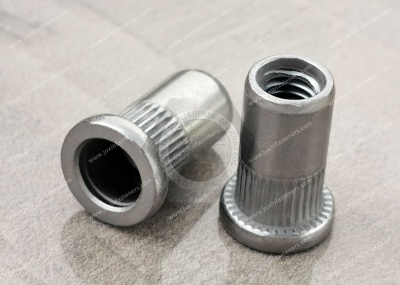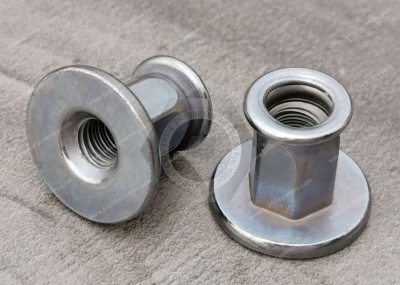Call Us
+86 136 6007 9809
Call Us
+86 136 6007 9809
Jun. 13, 2024
Surface protection of automotive fasteners and technology development
Automotive fasteners use the process in a harsh environment, especially fastening bolts, pipe hoops, elastic clamps, etc. Usually, corrosion is more serious, even due to corrosion caused by disassembly difficulties. Therefore, the fasteners must have good anti-corrosion performance. Currently used, the more common methods are surface zinc plating, zinc-nickel alloy, phosphating, blackening, Dacromet, and other treatments. Due to the restriction of hexavalent chromium content in the surface coating of automotive fasteners, which do not meet the standards of environmental protection directives, products containing hazardous substances are not allowed to enter the market, which puts forward an unprecedented high standard of environmental protection requirements for the innovative ability of automotive fastener surface treatment.
Flanged Socket Head Screws: Eliminate the need for a separate washer—these screws distribute pressure where the screw meets the surface without taking up as much space as a washer. Made of alloy steel, they are stronger than stainless steel screws. Their black-oxide finish provides mild corrosion resistance in dry environments. Head height includes the flange. Length is measured from under the flange.
Coarse threads are the industry standard; choose these screws if you don't know the pitch or the threads per inch. Fine threads are closely spaced to prevent loosening from vibration. They are not compatible with coarse threads.
Metric Alloy Steel Button Head Hex Drive Screws: These alloy steel screws are nearly twice as strong as stainless steel button head screws. Length is measured from under the head.
Black-oxide alloy steel screws are mildly corrosion-resistant in dry environments.
Zinc-plated alloy steel screws resist corrosion in wet environments. Screws with a blue-dyed finish have a distinctive blue color that makes them easy to distinguish. For high-quality Flanged Socket Head Screws fasteners and professional technical support, don't hesitate to co don't us at adelajonly@gmail.com or visit our website at [Juxin Fasteners]: https://www.juxinfasteners.com.


1. Water-based zinc and aluminum coating Jumite
Environmentally friendly new coating technology—flake zinc and aluminum coating GEOMET, EnOffer Group of companies for more than 30 years of Dacromet (DACROMET) based on surface rust prevention technology, after years of research and development, developed an utterly chrome-free surface treatment of the new technology—GEOMET.
GEOMET has the same structure as the Dacromet-treated film, in which the metal sheets are overlapped in layers to form a film that utilizes a silicone-based adhesive, thus covering the substrate.
Advantages of Jumet: Conductivity and high-strength metal flakes make Jumet bolts electrically conductive. Paint adaptability: Jumet can be used as a primer for most paints, including electroplating. The environmentally friendly, water-based solution does not contain chromium, and no wastewater is generated, no harmful substances are emitted into the air. Excellent corrosion resistance, only 6 to 8μm film thickness, can achieve salt spray test more than 1000h. Heat resistance, inorganic skin film, and the skin film do not contain moisture. No hydrogen embrittlement process, acid-free and electrolytic coating process, avoiding hydrogen embrittlement like ordinary plating process.
Stabilization of the coefficient of friction is essential for automotive fastener assembly. The solution for the coefficient of friction of aqueous zinc-aluminum flake coatings is to apply a lubricating aqueous inorganic topcoat, PLUS, on top of the zinc-aluminum coating. The types of PLUS and the range of coefficients of friction are as follows:
PLUS type and friction coefficient range
PLUS type Friction coefficient range (ISO16047)
PLUS XL 0.06 to 0.09
PLUS L 0.08 to 0.14
PLUS VL 0.09 to 0.14
PLUS ML 0.10 to 0.16
PLUS M 0.12 to 0.18
2. Electrophoretic coating technology
Some fasteners of some automobile companies use electrophoretic coating instead of passivation treatment after plating. The principle of electrophoretic coating is simply that "opposites attract," just like magnets. The paint is negatively charged for anodic electrophoresis-coated bolts in the anode, while the paint is positively charged for cathodic electrophoresis-coated bolts in the cathode. As we all know, electrophoretic coating is highly mechanized and environmentally friendly, and the paint film has excellent corrosion resistance. Water resources recycling and reuse, reduce emissions; strengthen heavy metal recycling to minimize emissions; reduce VOC (volatile organic compounds) emissions; reduce energy consumption (water, electricity, fuel, etc.), in line with the premise of environmental protection requirements, reduce costs, and improve quality.
In automotive parts and fasteners have been applied for several years; electrophoretic coating process is more mature, is to replace the electroplating products, PPGElect ropolyseal fasteners unique electrophoretic coating material, EPll/SST 120 ~ 200h anodic electrophoresis, EPL/SST 200 ~ 300h cathodic electrophoresis, EPlV/SST 500 ~ 1000h cathodic electrophoresis EP V/SST 1000~1500h cathodic electrophoresis; there is also ZiNC Rich coating zinc-rich organic coating (conductive).
With the development of technology, in addition to cathodic electrophoresis coating with excellent corrosion resistance, anodic electrophoresis coating with a certain degree of weathering resistance and edge corrosion-resistant cathodic electrophoresis coating are also practically applied in the production line. At present, PPG's electrophoretic coating series has been recognized by several automobile manufacturing companies, a series of specifications using a unified standard, S424 to S451, such as Ford WSS-M21P41-A2, S451; GM GM6047 code G; Chrysler PS-7902 Method C.
Electrophoretic coating is beneficial because it is good for the environment. Electrophoretic coating using water-based paint, passivation using trivalent chromium; improve product corrosion resistance, excellent adhesion; no plug holes, no plugging screw teeth, uniform film thickness, consistent torque value; traditional plating + passivation process, the salt spray test reaches about 144h. After adopting the zinc phosphating + zinc-rich primer + cathodic electrophoresis coating process, the salt spray test can reach more than 1,000h; if adopting the electroplating + cathodic electrophoresis coating process, the salt spray test can reach more than 500h. Comparison of salt spray test results of several film layers
(1) Zn phosphating + anodic electrophoresis: salt spray test / 120h
(2) Zn phosphating + cathodic electrophoresis: salt spray test/200-300h
(3) Zn phosphating + zinc-rich primer + cathodic electrophoresis: salt spray test/1000-1500h
(4) Electroplating + cathodic electrophoresis + top coating: cathodic electrophoresis: salt spray test/500-1000h
Conclusion
The future development of automotive fasteners will be more personalized, and the heat treatment process will highlight the characteristics of the service, intelligence, and green, lightweight technology, which will play an important role.
Contact Us
Tel.:
+86 020 8621 0320
+86 020 3121 6067
Technical Support:
Navigation
SEND INQUIREY